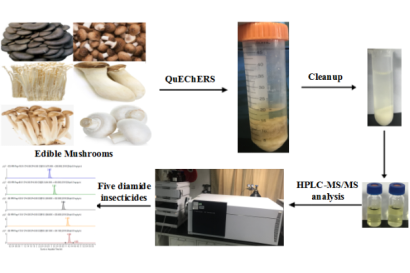China is the world’s largest producers and exporters of edible mushrooms. Because the production process of edible mushroomsis sealed, humid and invisible light, diseases and insect pestshave always been one of the main factors affecting the production andquality of edible mushrooms. Meanwhile, the incidence of pests anddiseases has become more and more serious, especially in some placeswith long cultivation time.However, so far, only oneinsecticide formulation (a mixture of beta-cyfluthrin and emamectinbenzoate) in China has been registered to control these pests.Diamide are a novel class of insecticides and have unique specifictarget site activity. Diamide insecticides exhibit remarkable selectivity and lowtoxicity to mammals.Up to now, somediamide active ingredients have been registered in different countries forpest control. Meanwhile, cyclaniliprole and tetrachlorantraniliprole arein the process of being registered on a global scale and approved for usein pest control. The maximum residue limits (MRLs) for diamideinsecticides (10 μg kg−1) except for tetrachlorantraniliprole in ediblemushrooms have been regulated in European Union (EU). In order to protect normal foreign trade for China and avoid economiclosses, it is important to establish reliable analytical methodsto screen their possible illegal use in edible mushrooms.

Schematic diagram of the detection process of diamide insecticides
In this study, a new method for simultaneous determination of diamide insecticides (cyantraniliprole, chlorantraniliprole, tetrachlorantraniliprole,cyclaniliprole and flubendiamide) in edible mushrooms by high-performance liquid chromatographycoupled to tandem mass spectrometry (HPLC-MS/MS) combined with a modified QuEChERS procedure.The determination of these insecticides was achieved in less than 5 min.The limits of detection and quantificationwere 0.05–2 μg kg−1 and 5 μg kg−1, respectively. Acceptable recoveries (73.5–110.2%) were acquired for theseinsecticides with RSDs less than 12.7%. The sensitivity and accuracy of the established method werebetter or equal to those of the previously reported methods. Meanwhile,the matrix of mushrooms was novel. Mushroom matrices wereverydifferent from vegetable and fruit matrices. Because mushrooms werefungi, the vegetables and fruits were plant. And this study is the first timethe QuEChERS method was applied to determine five diamide insecticidesresidues in edible mushrooms using HPLC–MS/MS. Given theabove, the proposed method is simple, rapid and low-cost, and it suit forroutine detection of five diamide insecticides in edible mushrooms.It is also an effectivemethod to study the MRLs of tetrachlorantraniliprole in ediblemushrooms. The results has been published in the Food Chemisry (IF: 6.306).
This study was finished by Prof. Hanzhong Xie’s lab from Zhengzhou Fruit Research Institute, CAAS.The first author and corresponding author are Dr. Fajun Tian and Prof. Hanzhong Xie, respectively. This work was supported by the Agricultural Science andTechnology Innovation Program (Grant CAAS-ASTIP-2019-ZFRI-10),the Central Public-interest Scientific Institution Basal Research Fund(No. 1610192020106), and the Quality and Safety Risk Assessment forAgro-Products of China (Grant GJFP 2019041).
The URL for this article should be:
https://www.sciencedirect.com/science/article/pii/S0308814620313303
By Tian Fajuntianfajun@caas.cn
